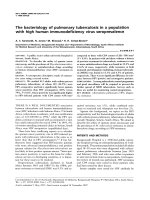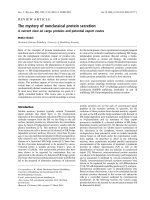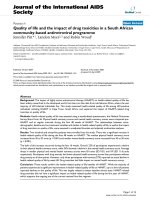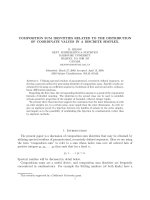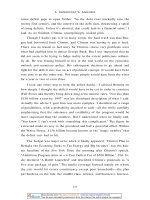- Trang chủ >>
- Khoa Học Tự Nhiên >>
- Vật lý
THE AMPLIFICATION OF CONFINED SOUND (CONFINED ACOUSTIC PHONONS) BY ABSORPTION OF LASER RADIATION IN a CYLINDRICAL QUANTUM WIRE WITH AN INFINITE POTENTIAL
Bạn đang xem bản rút gọn của tài liệu. Xem và tải ngay bản đầy đủ của tài liệu tại đây (880.58 KB, 4 trang )
Proc. Natl. Conf. Theor. Phys. 36 (2011), pp. 121-124
THE AMPLIFICATION OF CONFINED SOUND
(CONFINED ACOUSTIC PHONONS) BY ABSORPTION OF
LASER RADIATION IN A CYLINDRICAL QUANTUM WIRE
WITH AN INFINITE POTENTIAL
NGUYEN DINH NAM, NGUYEN QUANG BAU, NGUYEN THI QUYEN
Department of Physics, Hanoi University of Science, Hanoi, Vietnam
NGUYEN VU NHAN
Department of physics, Academy of Defence force-Air force, Hanoi, Vietnam
DINH QUOC VUONG
Quang Ninh Department of Education and Training, Quang Ninh, Vietnam
Abstract. The amplification of confined sound (confined acoustic phonons) by absorption of laser
radiation in a cylindrical quantum wire with an infinite potential is theoretically studied by using
a set of quantum kinetic equations for the electron phonon system. The analytic expression of
the amplification of confined sound G is obtained. Unlike the case of unconfined phonons, the
formula of G contains a quantum number m characterizing confined phonons. Their dependence
→
−
on the temperature T of the system, acoustic wave vector −
q , the frequency of acoustic wave ω→
q
and laser radiation Ω is studied. Numerical computations have been performed for GaAs/GaAsAl
quantum wire. The results have been compared with the case of unconfined phonons which show
that confined phonons cause some unusual effects.
I. INTRODUCTION
It is well known that when a laser radiation is applied to a material, the number of
acoustic phonons inside is varied with time. This studied phenomenon can lead to new
knowledge about the electron phonon interaction mechanism, especially in low dimensional structures. There have been a lot of works on the amplification of acoustic phonons
for bulk semiconductors [1-6] and for low dimensional semiconductors in the case of unconfined phonons [7-9]. However, the amplification of acoustic phonons by absorption of
laser radiation in quantum wire in the case of confined phonons has not been studied yet.
Therefore, in this paper, we have studied the amplification of confined sound (confined
acoustic phonons) by absorption of laser radiation in a cylindrical quantum wire with an
infinite potential. The comparison of the result of confined phonons to one of unconfined
phonons shows that confined phonons cause some unusual effects. To demonstrate this,
we estimate numerical values for a GaAs/GaAsAl quantum wire.
II. RATES OF ACOUSTIC PHONONS EXCITATION
Consider a cylindrical quantum wire with an confining infinite potential:
→
V (−
r)=
0
∞
if r < R
if r > R
(1)
122
NGUYEN DINH NAM, NGUYEN QUANG BAU, NGUYEN VU NHAN...
Here R is the radius of the cylindrical quantum wire. Electron wave function and energy
in this model have the form:
0
if r > R
(2)
ψn,l,kz (r, Φ, z) =
√1 eimΦ eikz z ψn,l (r)
if
r
0
εn,l (kz ) =
2 k2
2m∗
+
A2n,l
2
(3)
2m∗ R2
1
r
Jn (An,l ) is the radial wave function, m∗ is the effective
Jn+1 (An,l )
R
electron mass, Jn (x) is the Bessel function of the first kind, An,l is the lth test of the real
argument Bessel function at level n: Jn (An,l ) = 0.
With bulk phonon assumption, the Hamiltonian function for electron phonon
e→
εα (kz − A (t))c+
system in a quantum wire can be written as: H(t) =
α,kz cα,kz +
c
α,kz
ωa+ m,n,qz am,n,qz +
γI1D (qz )c+ α ,kz +qz cα,kz (am,n,qz +a+ n,m,−qz ), where c+
α,kz
m,n,qz
α, α , kz
m, n, qz
+
and cα,kz (a m,n,qz and am,n,qz ) are the creation and annihilation operators of electron (
phonon), kz and qz are the electron wave vector and the phonon wave vector (along the
wires axis : z axis ), γ is the interaction constant of electron acoustic phonon scattering,
I1D is the electron form factor, A(t) = Ωc E0 cos (Ωt) is the potential vector that depend
on the external field.
From the quantum kinetic equation for particle number operator of phonon
where ψn,l (r) =
Nm,n,qz (t) = a+ m,n,qz am,n,qz
t
(4)
∂Nm,n,qz (t)
= a+
(5)
m,n,qz am,n,qz , H(t) t
∂t
and the electron gas is degenerated in this case, we use Bolztmann distribution function
and use Hamiltonian in Eq (4), realizing calculations, we obtain quantum kinetic equation
for confined phonon in CQW. Using properties of Bessel function, fourier transformation, some approximation methods and realizing calculations, we obtain the coefficient
of the amplification of confined sound (confined acoustic phonons) by absorption of laser
radiation in a cylindrical quantum wire with an infinite potential:
i
G=
m∗ Lz
2π 3 qz
2
|γI1D (qz )|
α,α
2
2
m∗ Lz
m∗
exp
β
ε
−
ε
−
(
(A
−
λ)
−
q
)
z
F
α
2π 2 qz
2m∗ 2 qz
−
2
2
m∗
m∗ Lz
m∗
2
(A
−
λ)
exp
β
ε
−
ε
−
(A
+
λ)
−
q
)
+
(
z
F
α
2 2 qz2
2π 2 qz
2m∗ 2 qz
∗
m
− exp β(εF − εα − 2 2 (A + λ)2 .
(6)
2 qz
2B2
2B
2B2
2B2
2q2
e q z E0
α
z
α
α2
α
,
ε
=
,
λ
=
,
A
=
−
+
, Bα and
where εα =
α
2m∗ R2
2m∗ R2
m∗ Ω
2m∗ R2
2m∗ R2
2m∗
Bα are the tests of the Bessel function of the first kind, is the length of the quantum wire.
exp β(εF − εα −
THE AMPLIFICATION OF CONFINED SOUND BY...
123
The formula of the amplification of confined sound contains the quantum number
m characterizing confined phonons and is easy to come back to the case of unconfined
phonons.
III. NUMBERICAL RESULTS AND DISCUSSISONS
Fig. 1. The dependence of G on the frequency of laser radiation
Fig. 2. The depence of G on the acoustic wave vector
The obtained results are much different from the previous work on bulk semiconductors [3-5] and in the case of unconfined phonons. From these results, using numberial
data for GaAs/GaAsAl quantum wire: Vs = 4078ms−1 , Lz =100.10−10 (m), R=5.10−9 (m),
m∗ = 0.066.m0 ,ρ = 5.3103 kgm−3 , εF =0.05.16.10−19 (J). We plot the dependence of the
rate of confined acoustic phonon on acoustic wave vector and on the frequency of laser
124
NGUYEN DINH NAM, NGUYEN QUANG BAU, NGUYEN VU NHAN...
radiation. We see that the amplification of confined acoustic phonons also depends on
the frequency of acoustic wave, temperature of system. These dependences are much
more than in case of unconfined phonons, this is consistent with the theory that possible
combinations increase in the case of confined phonons.
IV. CONCLUSION
In this paper, the amplification of confined acoustic phonons by absorption of laser
radiation is investigated. We obtained a general dispersion equation for the amplification
of confined acoustic phonons. However, an analytical solution to the equation can only
be obtained within some limitations. Using these limitations for simplicity, similarly to
the mechanism pointed out by several authors for bulk semiconductors [1-6] and for low
dimensional semiconductors [7-9], we have numerically calculated and graphed the amplification of confined sound by absorption of laser radiation for GaAs/GaAsAl cylindrical
quantum wire with an infinite potential clearly show the predicted mechanism. Unlike the
case of unconfined phonons, the formula of the amplification of confined sound contains a
quantum number m characterizing confined phonons. Their dependence on the temper→
→
ature T of the system, acoustic wave vector −
q , the frequency of acoustic wave ω−
q and
laser radiation Ω is studied. The results have been compared with the case of unconfined
phonons which show that confined phonons cause some unusual effects and is easy to come
back to the case of unconfined phonons.
ACKNOWLEDGMENT
This work is completed with financial support from the Vietnam National Foundation for Science and Technology Development (NAFOSTED), Hanoi University of Sciences
(TN 11-07).
REFERENCES
[1]
[2]
[3]
[4]
[5]
[6]
[7]
E. M. Epstein, Radio in Physics 18 (1975) 785.
E. M. Epstein, Lett. JEPT 13 (1971) 511.
Peiji Zhao, Phys. Rev. B 49 (1994) 13589.
V. A. Geyler, V. A. Margulis, Phys. Rev. B 61 (2000) 1716.
L. Sholimal, Tunnel effects in semiconductors and applications, Moscow (1974).
Nguyen Hong Son, G. M. Shmelev, E. M. Epstein, Izv. VUZov USSR, Physics 5 (1984) 19.
Nguyen Quang Bau, Vu Thanh Tam, Nguyen Vu Nhan, J. Science and Technical Investigations in
Army 3 (24) (1998) 38.
[8] Nguyen Quang Bau, Nguyen Vu Nhan, Chhoumm Navy, VNU Journal of Science 2 (1991) 1.
[9] Nguyen Quang Bau, Nguyen Vu Nhan, Nguyen Manh Trinh, Proceedings of IWOMS99, Hanoi (1999),
p. 869.
Received 30-09-2011.
